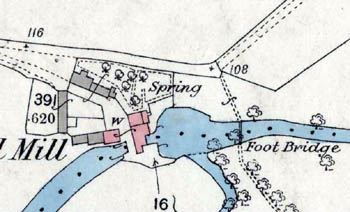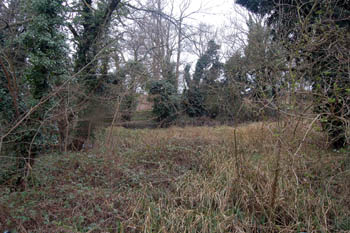Stanford Mill

Site of Stanford Mill, 1881
Domesday
The Domesday Book of 1086 records a number of holdings in Stanford as well as a number of mills. The major owner, Eudo, son of Hubert, had a holding with two mills valued together at 29 shillings and 50 eels. Another landowner was Hugh de Beauchamp (made Baron of Bedford within ten years by William II) who had a number of small pieces of land one of which, tenanted by one Roger, had half a mill, valued at 5/-. William Speke owned a small area of land, tenanted by a certain Hugh, it, too, contained half a mill valued at 5/-, presumably the other half of that owned by Hugh de Beauchamp and tenanted by Roger. Azelina, Ralph Tallboys' wife was recorded as having land tenanted by Roger (perhaps the same as that tenanting Hugh de Beauchamp's land), this holding also included a mill - a total of four mills. It should be noted that this does not necessarily mean four mill buildings as later on a mill came to be regarded as a pair of grinding stones - thus Shefford Mill was known as Shefford Mills and was recorded as five mills because it had five pairs of stones.
Medieval Murder
Volume XLI of the Bedfordshire Historical Records Society was Bedfordshire Coroner's Rolls translated from rolls at The National Archives by R.F.Hunnisett in 1961. Entry 48 tells of a murder near the mill: "About vespers [i.e. in the evening] on 15th November 1269 Ralph del Louwe of Stamford went towards Stanford mill in "Hageyorfurlong" on the fee of the abbot of Old Warden, and met felons and thieves, who took and bound him and struck him with a knife under the right side and on the hattrel of the brain, of which he immediately died. His wife Millicent was troubled because he did not return that night, and at dawn the next day searched for him and found him dead in the said place…Inquest before G.Rodlond, coroner, by Southill, Stanford, Langford and Henlow, who said that on the day of the felony the felons came from the house of Hugh le Champiman, a receiver of felons. It was ordered that he be arrested". By the time of the Eyre at Bedford the felons were still unknown.
The 18th and 19th Centuries
There is no further mention of a mil lat Stanford in any document held by Bedfordshire Archives until a family settlement of 1792 [ref: SL1/2-3] by Robert Henley, 2nd Baron Ongley who owned a messuage and watermill in Stanford and 18 acres 2 roods of land. It seems reasonable to assume that he owned the mill because he owned the two manors in Stanford, called Stanford Manor and Stanfordbury Manor which were the later incarnations of the land owned by the four individuals at Domesday. Eight years later Ongley made a series of exchanges of land with Samuel Whitbread and conveyed him a watermill called Stanford Mill, yard and pasture and one acre, two roods, twenty one perches in occupation of William Squire [ref: SL1/13].
By 1847 Stanford Mill was leased from the Whitbread Estate by Edmund Powers. This family continued to lease the mill until 1916 when they sold all the stock. Edmund Powers is shown as miller until 1862, directories from 1869 noting the millers as Edmund Powers & Sons who ran the operation through a series of agents acting as millers. In a document of 1884 Powers & Sons are described as millers at Biggleswade, Holme, Stanford, Langford and Albion Mills near King's Cross, London. The document is an agreement with Biggleswade bankers Wells, Hogge & Lindsell. Originally the two brothers Charles and Edmund Powers had run separate milling firms but after Charles' death his two sons were not sufficiently able to run their father's business so the eldest son of Edmund Powers ran both businesses. Sadly he was a poor businessman as well as somewhat unscrupulous and both firms ended up by going bankrupt.

Site of Stanford Mill pond, March 2008
The 20th Century
By 1916 the mill was no longer in use and in that year J.R.Eve & Son were instructed to sell off the stock. A draft catalogue [ref: Z740/114/2] notes that not only the mill stock but the lease of the Mill Farm were up for sale. The description of the sale items is as follows: "Agricultural Buildings including a valuable Onion and Seed Loft with stable and cart shed under 50 feet by 30 feet. Covered yard 35 feet by 31½ feet; 6 bay return shed, etc. The substantially built mill - milling plant and machinery comprising elevators, four pairs of stones, dressing reels and mixers, Eureka separating and scouring machine, 30 driving reels, steel shafting and pulleys, centrifugal dressing machine, 10 foot purifier, set of double rolls, sack tackle etc. etc. 30hp compound tender type engine by Robey".
In 1927 Stanford was valued under the Rating Valuation Act 1925; every piece of land and building in the country was assessed to determine the rates to be paid on it. The valuer visiting Stanford Mill Farm [DV1/H50/24] noted that it was owned by the Whitbread Estate and tenanted by Hugh B.Larby, who paid £140 per annum rent. The mill included 59 acres of land and the valuer commented: "Small buildings wood and tile in poor state. Part of land is liable to flood. Rent looks very high 36/6 per acre, 2¾ miles from station". The house contained two living rooms, a kitchen and two bathrooms with a small barn outside. There is no mention of the mill itself which had, presumably, been demolished.
Known tenants of Stanford Mill, mostly gleaned from directories [the dates being those in which they are known to have been there rather than their entire tenure]:
1800: William Squire;
1847-1862: Edmund Powers;
1869-1871: John Nutting;
1877-1885: Charles Williamson;
1890-1903: William Dilley